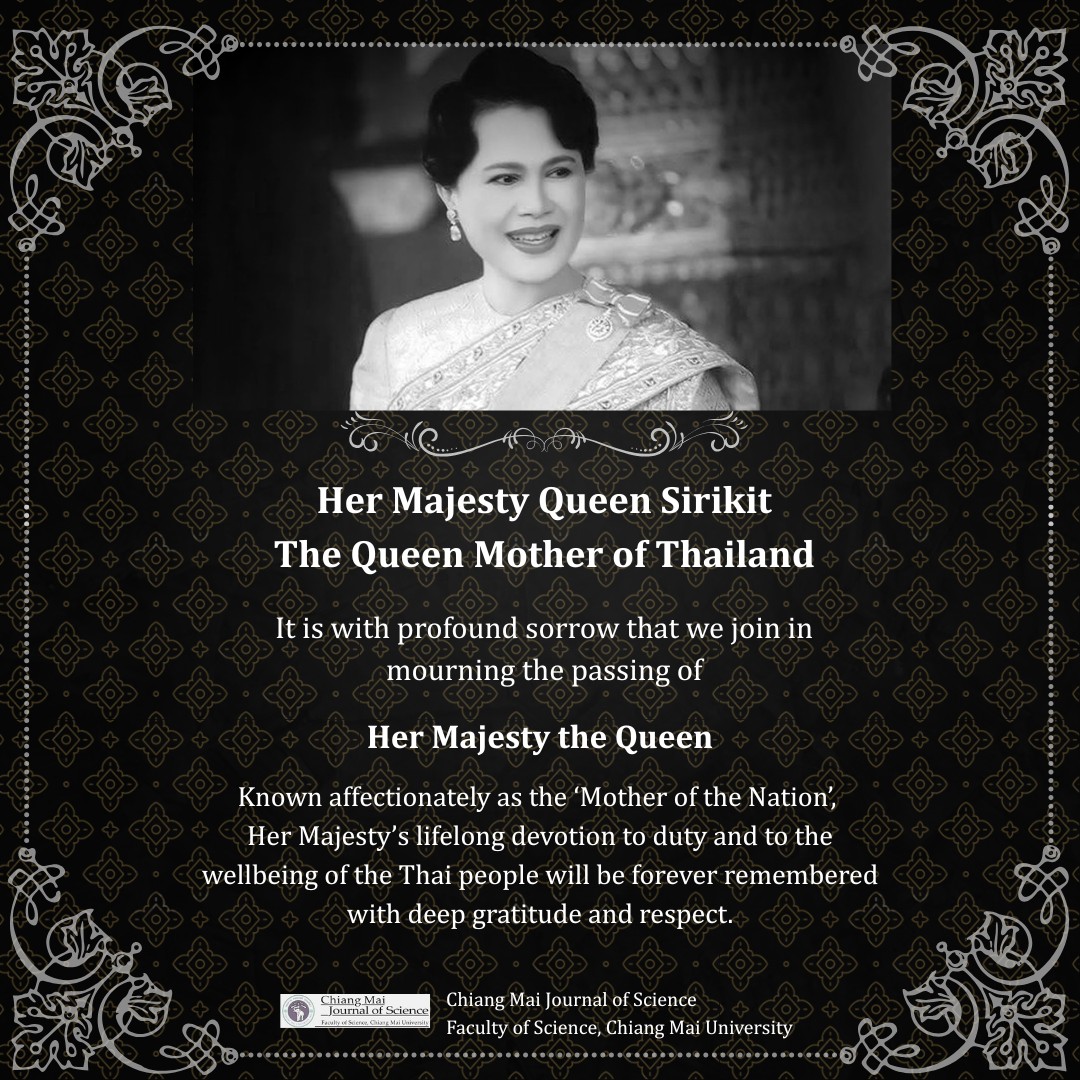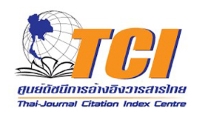JOURNAL DETAIL
Molecular Aggregation of Four Modified Xyloglucan Models in Aqueous Solution
Paper Type |
Contributed Paper |
Title |
Molecular Aggregation of Four Modified Xyloglucan Models in Aqueous Solution |
Author |
Napat Kongtaworn, Namon Hirun, Vimon Tantishaiyakul, Thanyada Rungrotmongkol and Supaporn Dokmaisrijan |
Email |
sdokmaisrijan@yahoo.com |
|
Abstract: Tamarind seed xyloglucan (TSX) is extracted from tamarind seeds and is one of the most useful natural polymers. It has been used as a drug carrier in drug delivery because of its non-toxicity, biodegradability, and biocompatibility. A solution of TSX can become a thermally reversible TSX hydrogel when its galactose molecules are partially removed. It was found that a galactose-removed TSX hydrogel is formed when two modified TSX chains form parallel-like structure in aqueous solution. Many molecular associations via hydrogen bonds between two modified TSX chains can promote its molecular aggregation. Moreover, it was reported that the lack of galactose molecules might be able to promote the aggregation of the b-glucan main chains through the hydrophobic interactions, resulting in the gelation. In this study, four double-chain TSX models with 50% galactose removal were used for the study of molecular aggregation in aqueous solution at its gelling temperature. Each model was built from eight monomer units of nonasaccharide (N, XLLG) and eight monomer units of heptasaccharide (H, XXXG), where G, X, and L are glucose (Glu), xylose (Xyl) substituted with glucose, and galactose (Gal) substituted with xyloglucose, respectively. The numbers of N and H are equal in all models, but the arrangements of N and H monomer units in each model are different. The simulated SAXS profiles of all models were also carried out. The roles of molecular structures, intermolecular interactions, and molecular arrangements in molecular aggregation of 50% galactose removal of two TSX chains are discussed. |
|
Start & End Page |
2201 - 2210 |
Received Date |
2017-11-01 |
Revised Date |
|
Accepted Date |
2018-04-30 |
Full Text |
Download |
Keyword |
Tamarind seed xyloglucan, hydrogel, SAXS, MD simulation |
Volume |
Vol.45 No.5 (Special 2018) |
DOI |
|
Citation |
Kongtaworn N., Hirun N., Tantishaiyakul V., Rungrotmongkol T. and Dokmaisrijan S., Molecular Aggregation of Four Modified Xyloglucan Models in Aqueous Solution, Chiang Mai Journal of Science, 2018; 45(5): 2201-2210. |
| View:964 Download:290 | |
RELATED ARTICLE
Study on the Eco-friendly Cleaning Technology for Efflorescence on Structural Surfaces
Article ID: e2025081
Author:Ruitao Wu, Wenhao Guo, Weixiong Chen, Donghua Liang and Yu Qiu
Vol.52 No.6 (November 2025). View: 317 Download:141
Article ID: e2025081
Author:Ruitao Wu, Wenhao Guo, Weixiong Chen, Donghua Liang and Yu Qiu
Vol.52 No.6 (November 2025). View: 317 Download:141
Optimization of Chitosan-Alginate Hydrogel Properties for Controlled Release of Urea
Article ID: e2025008
Author:Melody Kimi and Chee Jiun Chong
Vol.52 No.1 (January 2025) View: 692 Download:833
Article ID: e2025008
Author:Melody Kimi and Chee Jiun Chong
Vol.52 No.1 (January 2025) View: 692 Download:833
Clindamycin Hydrochloride-loaded Composite Hydrogel of Poly((ethylene glycol) dimethacrylate-glycidyl methacrylate) and Mesoporous Silica Nanoparticles for Bacterial Infection Treatment
page: 765 - 775
Author:Piyarat Sungkhaphan, Boonlom Thavornyutikarn, Pakkanun Kaewkong, Weerachai Singhatanadgit, Soraya Pornsuwan and Wanida Janvikul*
Vol.47 No.4 (Special Issue II : July 2020) View: 1,055 Download:840
page: 765 - 775
Author:Piyarat Sungkhaphan, Boonlom Thavornyutikarn, Pakkanun Kaewkong, Weerachai Singhatanadgit, Soraya Pornsuwan and Wanida Janvikul*
Vol.47 No.4 (Special Issue II : July 2020) View: 1,055 Download:840
Kinetic Study of Ibuprofen Release from a pH- and Temperature-sensitive Hydrogel, Based on Poly(styrene-alt-maleic anhydride) Copolymer
page: 224 - 236
Author:Morteza Bahram, Fariba Hoseinpour, Naimeh Mohseni and Peyman Najafi-Moghaddam
Vol.44 No.1 (JANUARY 2017) View: 893 Download:682
page: 224 - 236
Author:Morteza Bahram, Fariba Hoseinpour, Naimeh Mohseni and Peyman Najafi-Moghaddam
Vol.44 No.1 (JANUARY 2017) View: 893 Download:682
Polymer-Peptide Conjugate Hydrogels; Towards Controlled Drug Delivery
page: 351 - 372
Author:Arun A. Sohdi, Darren Campbell andPaul D. Topham*
Vol.39 No.3 (JULY 2012) View: 769 Download:318
page: 351 - 372
Author:Arun A. Sohdi, Darren Campbell andPaul D. Topham*
Vol.39 No.3 (JULY 2012) View: 769 Download:318
Design and Preparation of AMPS-Based Hydrogels
for Biomedical Use as Wound Dressings
page: 183 - 189
Author:Kanarat Nalampang, Nantarat Suebsanit, Chinanat Witthayaprapakorn, and Robert Molloy
Vol.34 No.2 (MAY 2007) View: 921 Download:293
page: 183 - 189
Author:Kanarat Nalampang, Nantarat Suebsanit, Chinanat Witthayaprapakorn, and Robert Molloy
Vol.34 No.2 (MAY 2007) View: 921 Download:293
A Smart Hydrogel-Based System for Controlled Drug
Release
page: 471 - 478
Author:Patchara Punyamoonwongsa * and Brian J. Tighe
Vol.32 No.3 (SEPTEMBER 2005) View: 829 Download:261
page: 471 - 478
Author:Patchara Punyamoonwongsa * and Brian J. Tighe
Vol.32 No.3 (SEPTEMBER 2005) View: 829 Download:261
Theoretical Study of the Bombyx mori Silk Surface
Functionalization: Quantum Mechanical Calculation
of the Glycine-Alanine Unit Reacting with Fluorine
and Molecular Dynamic Simulation of Wettability
page: 106 - 115
Author:Padungsee Khomhoi, Waleepan Sangprasert, Vannajan S. Lee, and Piyarat Nimmanpipug
Vol.37 No.1 (JANUARY 2010) View: 899 Download:265
page: 106 - 115
Author:Padungsee Khomhoi, Waleepan Sangprasert, Vannajan S. Lee, and Piyarat Nimmanpipug
Vol.37 No.1 (JANUARY 2010) View: 899 Download:265
Synthesis and Characterisation of Poly(2-hydroxyethyl methacrylate-co-methyl acrylate) Hydrogels for Use as Temporary Skin Substitutes
page: 71 - 82
Author:Tiwaporn Siriwittayakorn [a], Nantarat Suebsanit [a], Robert Molloy [a], Paisit Siriwittayakorn [b] and Malinee Prasitsilp [c]
Vol.28 No.2 (DECEMBER 2001) View: 835 Download:267
page: 71 - 82
Author:Tiwaporn Siriwittayakorn [a], Nantarat Suebsanit [a], Robert Molloy [a], Paisit Siriwittayakorn [b] and Malinee Prasitsilp [c]
Vol.28 No.2 (DECEMBER 2001) View: 835 Download:267
Copyrights © Since 2021 All Rights Reserved by Chiang Mai Journal of Science










